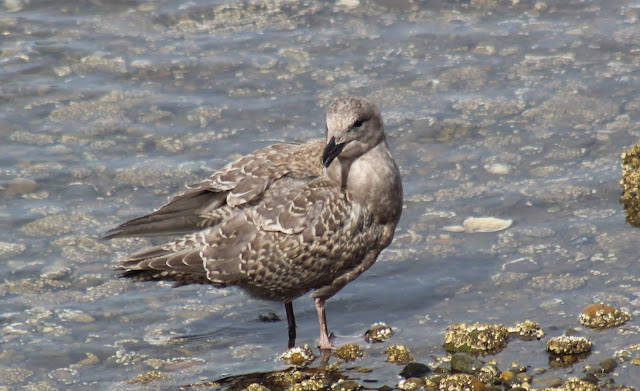It’s been a while since I’ve been
home mid-week, so decided to go out to the Nisqually National Wildlife Refuge. That said, this post was shamelessly plagiarized from Volunteer Shep Thorp's account to the Tweeters birding group.
 |
| Greeted by a Black-capped Chickadee |
Volunteers lead a walk every Wednesday at 8
a.m. from the Refuge Visitors’ Center.
Today, about 28 of us enjoyed a beautiful summer’s day at the Refuge
with temperatures in the 60s to 80s Fahrenheit.
One of our leaders, Phil Kelley began the walk with us, but peeled off
to lead a student field trip visiting from Pacific Lutheran University.
Starting out at
the Visitors’ Center Pond Overlook, we were greeted by an immature Green Heron
hunting in the pond.
 |
| You can tell it's an immature because it has streaks on the breast. |
Swallows were
scarce, as the numbers have significantly dropped with migration in full swing. Only two Barn Swallows were seen at the start
of the walk. A Great Blue Heron perched
high on a snag.
 |
| This and the Green Heron photo stolen from Shep Thorp |
Refuge staff were
busy mowing the high grass from the fields, to provide habitat for wintering
waterfowl. Water could be heard along
the west side of the Visitor Center, as the pumps are turned on to begin
flooding the dried up - and newly-mowed - fields.
The Heritage Orchard
was good for American Goldfinch, Cedar Waxwing, Black-capped Chickadee, Chestnut-backed
Chickadee, and Anna’s Hummingbird. In the
stand of trees opposite the entrance road and adjacent to the entrance to the Access
Road Wilson’s Warbler, Bewick’s Wren and Steller’s Jays were observed. A Hairy Woodpecker was heard calling in the
tall stand between the parking lots and the Access Road.
 |
| Chestnut-backed Chickadee |
Near the west
entrance to the Twin Barns Loop Boardwalk, we picked up Purple Finch, Oregon
Junco, and White-crowned Sparrow.
 |
| Keep away from the Bald-faced Hornet nest . . . |
Along the boards we had nice looks of Common
Yellowthroat, Orange-crowned Warbler, Brown Creeper and Warbling Vireo. From the first observation platform, we saw
Red-shafted Flicker and Columbian Black-tailed Deer.
The cut-off to the Twin Barns was really
hopping with a family of four Willow Flycatchers busy foraging and very nice
looks of Black-throated Gray Warbler and Common Yellowthroat.
 |
| Orange-crowned Warbler Leiothlypis celata lutescens |
We usually stop for a mid-morning snack at the Twin Barns overlook, before going out onto the north dike. There were
distant Common Ravens calling across the surge plain, with Bald Eagle, Red-tailed
and Cooper’s Hawks. A male American
Kestrel was observed hunting from one of the snags, then was observed chasing a
Least Sandpiper. When last seen, he was
eating lunch. The fresh water marsh on
the inside of the dike was good for American Bittern, Mallard, Cinnamon Teal
and Northern Shoveler.
Out on the
Nisqually Estuary Trail, we were greeted with a low -1.89 foot tide at 10:35
p.m., which resulted in quite the mudflat for us to search.
 |
| This is covered by water on a high tide |
The Refuge is working with the contractor to
complete construction on the new bridge over a tributary off Shannon Slough. Off-and-on, the boardwalk has been closed
this year, due to the work.
 |
| This is the time of the year that young Cowbirds forage on the mud flats |
Two Hooded
Mergansers were seen near the photo blind, and several small groups of peeps, including
Least and Western Sandpiper, were seen flying over the mudflats. A large group of more than 20 Killdeer were
foraging around the McAllister Creek Viewing Platform.
 |
| California Gulls in front, Ring-billed Gulls in back |
With the low tide
we had nice observation of Gulls and Eagles foraging on Pacific Sand Lance from
the sandy bottom of the creek. Ring-billed,
California, Glaucous-winged, and Western Gulls were identified, along with the more-common
hybrid “Olympic” Gulls. We searched for
and found two Spotted Sandpipers along the west bank of McAllister Creek, a Belted
Kingfisher from the Puget Sound Observation Platform and Purple Martins near
the nest boxes at the Luhr Beach.
 |
| Luhr Beach is a WDFW-owned facility |
Double-crested
and Brandt’s Cormorants were observed out on Nisqually Reach. We saw about 10 Caspian Terns, but were not
able to relocate the Franklin's Gull and Common Tern reported earlier in the
last two weeks. As the tide shifted many
hundreds of waterfowl took flight and we were able to count hundreds of Northern
Pintails, mixed with Mallards, and a few dozen American Wigeon.
 |
| From the Estuary Boardwalk, one can see the Tacoma Narrows Bridge (right of Anderson Island) |
On our return
along the east side of the Twin Barns boardwalk loop, there were Western Wood
Pewee, Pacific-slope Flycatcher, American Goldfinch, and more chickadees. A single Golden-crowned Kinglet was observed
at the Riparian Forest Overlook, soon after we watched a mink foraging for its
lunch.
In all, we saw 66
bird species for the day, as well as some cool mammals, with 157 avian species for the year for the Wednesday Walk. All and sundry are welcome to attend this
walk. I’d love to meet you out birding there.
Nisqually NWR eBird Checklist is Here
 |
| Drake Wood Duck in "Eclipse" plumage |





























